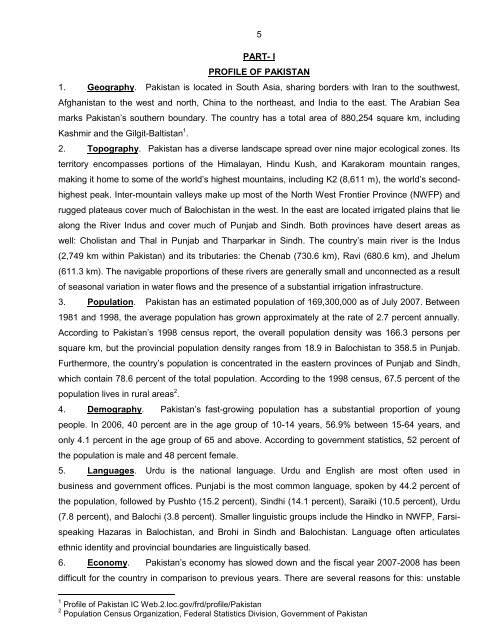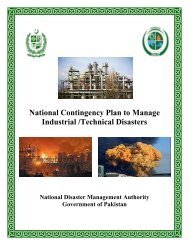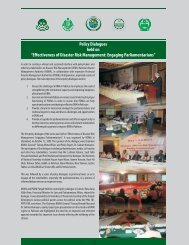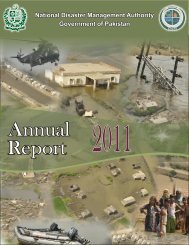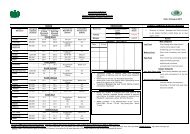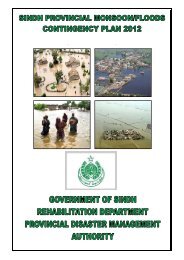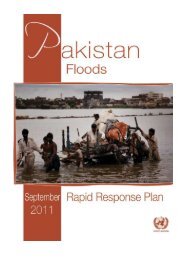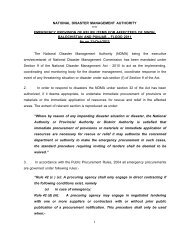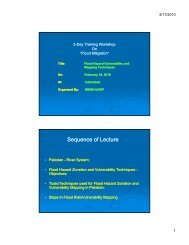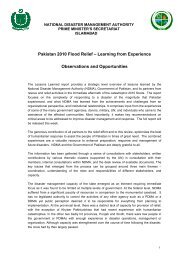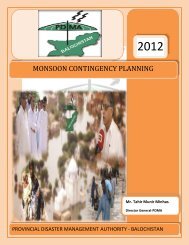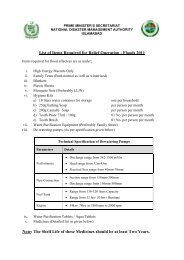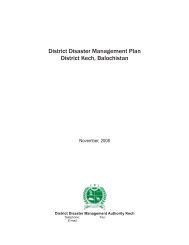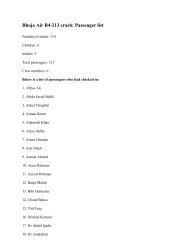National Disaster Response Plan (NDRP) March 2010 - NDMA
National Disaster Response Plan (NDRP) March 2010 - NDMA
National Disaster Response Plan (NDRP) March 2010 - NDMA
You also want an ePaper? Increase the reach of your titles
YUMPU automatically turns print PDFs into web optimized ePapers that Google loves.
5<br />
PART- I<br />
PROFILE OF PAKISTAN<br />
1. Geography. Pakistan is located in South Asia, sharing borders with Iran to the southwest,<br />
Afghanistan to the west and north, China to the northeast, and India to the east. The Arabian Sea<br />
marks Pakistan‟s southern boundary. The country has a total area of 880,254 square km, including<br />
Kashmir and the Gilgit-Baltistan 1 .<br />
2. Topography. Pakistan has a diverse landscape spread over nine major ecological zones. Its<br />
territory encompasses portions of the Himalayan, Hindu Kush, and Karakoram mountain ranges,<br />
making it home to some of the world‟s highest mountains, including K2 (8,611 m), the world‟s second-<br />
highest peak. Inter-mountain valleys make up most of the North West Frontier Province (NWFP) and<br />
rugged plateaus cover much of Balochistan in the west. In the east are located irrigated plains that lie<br />
along the River Indus and cover much of Punjab and Sindh. Both provinces have desert areas as<br />
well: Cholistan and Thal in Punjab and Tharparkar in Sindh. The country‟s main river is the Indus<br />
(2,749 km within Pakistan) and its tributaries: the Chenab (730.6 km), Ravi (680.6 km), and Jhelum<br />
(611.3 km). The navigable proportions of these rivers are generally small and unconnected as a result<br />
of seasonal variation in water flows and the presence of a substantial irrigation infrastructure.<br />
3. Population. Pakistan has an estimated population of 169,300,000 as of July 2007. Between<br />
1981 and 1998, the average population has grown approximately at the rate of 2.7 percent annually.<br />
According to Pakistan‟s 1998 census report, the overall population density was 166.3 persons per<br />
square km, but the provincial population density ranges from 18.9 in Balochistan to 358.5 in Punjab.<br />
Furthermore, the country‟s population is concentrated in the eastern provinces of Punjab and Sindh,<br />
which contain 78.6 percent of the total population. According to the 1998 census, 67.5 percent of the<br />
population lives in rural areas 2 .<br />
4. Demography. Pakistan‟s fast-growing population has a substantial proportion of young<br />
people. In 2006, 40 percent are in the age group of 10-14 years, 56.9% between 15-64 years, and<br />
only 4.1 percent in the age group of 65 and above. According to government statistics, 52 percent of<br />
the population is male and 48 percent female.<br />
5. Languages. Urdu is the national language. Urdu and English are most often used in<br />
business and government offices. Punjabi is the most common language, spoken by 44.2 percent of<br />
the population, followed by Pushto (15.2 percent), Sindhi (14.1 percent), Saraiki (10.5 percent), Urdu<br />
(7.8 percent), and Balochi (3.8 percent). Smaller linguistic groups include the Hindko in NWFP, Farsi-<br />
speaking Hazaras in Balochistan, and Brohi in Sindh and Balochistan. Language often articulates<br />
ethnic identity and provincial boundaries are linguistically based.<br />
6. Economy. Pakistan‟s economy has slowed down and the fiscal year 2007-2008 has been<br />
difficult for the country in comparison to previous years. There are several reasons for this: unstable<br />
1 Profile of Pakistan IC Web.2.loc.gov/frd/profile/Pakistan<br />
2 Population Census Organization, Federal Statistics Division, Government of Pakistan


